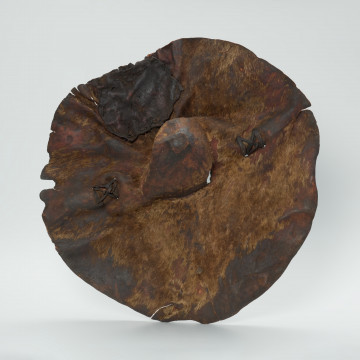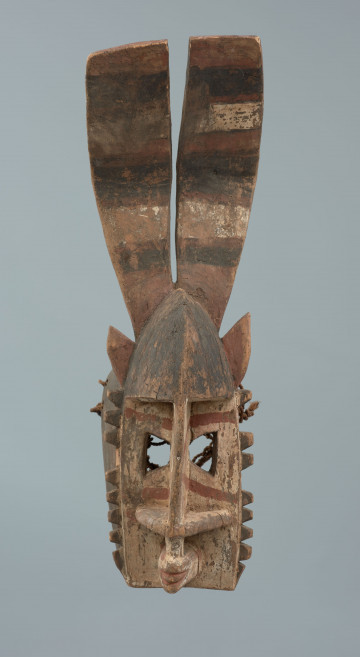
Props for highwayman's mask (leather shield, dance baton)
między 1901 — 1947
National Museum in Szczecin
Part of the collection: Collection of Dogonian art
The yona mask represents a ritual thief. Among the Dogon there are organised and specialised Yona groups, membership of which is inherited from father to son. In the event of one of the group members’ death, the ritual thieves organise a looting expedition, usually to a neighbouring village. Their prey is domestic animals (sheep, goats, chickens). The stolen animals are sacrificed in the house where the deceased lived and then eaten together by all members of the group. The owners of the stolen animals cannot protest, because Yona commemorate the deed of the mythical Blacksmith, who risked his life to steal fire and pass it on to the people. The mythical Blacksmith appeared on Earth, after the Ark with Nommo and the ancestors had already landed on Earth. He did not move in the ark but, as the Dogon say, descended, landing on Earth like a frog in a cave called Diama Konoma. He came in the company of his twin sister, because at the beginning of the creation and organisation of life on Earth everyone appeared in pairs. He brought with him cereal grains whose souls were housed in an iron butterfly. He stole a piece of the sun with an iron hook and used it to light a fire in the forge and then made hoes in the forge so that people could become farmers. The Blacksmith became a master of fire, possessed the knowledge to extract iron from minerals and produce weapons, tools and other necessary items. He shared all his skills with the people.The yona mask is made of fibres. Its attributes are the yo dommolo (thief's staff) representing a horse and a bunch of keys symbolising access to the Dogon homesteads. She dances during the Dama funeral rituals. Like the other Dogon masks, it belongs to the secret Awa society.
Ewa Prądzyńska
Author / creator
Dimensions
cały obiekt: height: 43 cm, width: 31 cm
Object type
dancing prop, mask
Creation time / dating
Creation / finding place
Identification number
Location / status

między 1901 — 1947
National Museum in Szczecin

między 1951 — 2000
National Museum in Szczecin

między 1951 — 2000
National Museum in Szczecin
DISCOVER this TOPIC
Museum of King Jan III's Palace at Wilanów
DISCOVER this PATH
Educational path